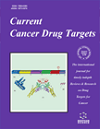- Home
- A-Z Publications
- Current Cancer Drug Targets
- Previous Issues
- Volume 11, Issue 5, 2011
Current Cancer Drug Targets - Volume 11, Issue 5, 2011
Volume 11, Issue 5, 2011
-
-
Post-Translational Modifications of PTEN and their Potential Therapeutic Implications
More LessAuthors: G. Singh and A. M. ChanPTEN is a tumor suppressor gene localized to human chromosome 10q23.31, a genomic region frequently lost in glioblastoma and prostate cancer. The fact that PTEN encodes a lipid phosphatase with specificity towards phosphatidylinositol-3,4,5-triphosphate renders it a gate-keeper of the phosphatidylinositol 3-kinase pathway. Numerous physiological processes have been ascribed to this evolutionarily conserved molecule i Read More
-
-
-
A Cross-Talk Between NFAT and NF-κB Pathways is Crucial for Nickel- Induced COX-2 Expression in Beas-2B Cells
More LessCyclooxygenase-2 (COX-2) is a critical enzyme implicated in chronic inflammation-associated cancer development. Our studies have shown that the exposure of Beas-2B cells, a human bronchial epithelial cell line, to lung carcinogenic nickel compounds results in increased COX-2 expression. However, the signaling pathways leading to nickel-induced COX-2 expression are not well understood. In the current study, we found tha Read More
-
-
-
Targeting Aldose Reductase for the Treatment of Cancer
More LessAuthors: R. Tammali, S. K. Srivastava and K. V. RamanaIt is strongly established by numerous studies that oxidative stress-induced inflammation is one of the major causative agents in a variety of cancers. Various factors such as bacterial, viral, parasitic infections, chemical irritants, carcinogens are involved in the initiation of oxidative stress-mediated inflammation. Chronic and persistent inflammation promotes the formation of cancerous tumors. Recent investigations strong Read More
-
-
-
CD44-Targeting for Antitumor Drug Delivery: A New SN-38-Hyaluronan Bioconjugate for Locoregional Treatment of Peritoneal Carcinomatosis
More LessAuthors: A. Serafino, M. Zonfrillo, F. Andreola, R. Psaila, L. Mercuri, N. Moroni, D. Renier, M. Campisi, C. Secchieri and P. PierimarchiAn innovative approach for cancer therapy implies the use of drugs covalently conjugated to macromolecular carriers that specifically target molecules over-expressed on tumor cells. This drug delivery strategy may allow a controlled release of the drug and a high targeting selectivity on tumor cells, increasing drug cytotoxicity and decreasing its undesirable side effects. We provide in vitro and in vivo preclinical data on th Read More
-
-
-
The Pro-Survival Function of Akt Kinase can be Overridden or Altered to Contribute to Induction of Apoptosis
More LessAuthors: D. M. Benbrook and C. P. MasamhaThe Serine/Threonine protein kinase B (PKB), which is now called Akt, has well-documented oncogenic potential and pro-survival activities that can counteract apoptosis induced by anti-cancer drugs. The goal of this review is to discuss current evidence that the pro-survival function of Akt can be overridden or converted to a pro-apoptotic function. A brief description of how upstream regulators and downstream effectors of the Read More
-
-
-
The Centrosome: A Target for Cancer Therapy
More LessAuthors: M. Mazzorana, G. Montoya and G. B. MortuzaThe centrosome plays an essential role in cell cycle progression and cell polarity, organizing the microtubule network in interphase and mitosis. During cell division, the centrosome undergoes a series of structural and functional transitions and forms the two poles of the bipolar mitotic spindle. It is the microtubule cytoskeleton that is reorganized to form the two poles, ensuring accurate separation of the two daughter c Read More
-
-
-
Drug Resistance: Challenges to Effective Therapy
More LessThe success of current treatment strategies is limited by the development of therapy resistance as evidenced by recurrence of the primary tumor or distant metastasis. Eradication of primary and metastatic disease requires interventions at both the cancer cell and tumor microenvironment levels. In this review, we will discuss mechanisms that are intrinsic to cancer cells, and those that are mediated by the tumor microenvir Read More
-
-
-
VEGF/VEGFR Pathway Inhibitors as Anti-Angiogenic Agents: Present and Future
More LessAuthors: P. S. Sharma, R. Sharma and T. TyagiAngiogenesis, the formation of new blood vessels from pre-existing ones, plays a central role in the process of tumor growth and metastasis. The proliferation of endothelium and formation of new blood vessels further the size of solid tumors. It is expected that blocking angiogenesis will be an efficient therapeutic approach against many tumor types. The key signaling system that regulates proliferation and migration of endoth Read More
-
-
-
Malignant Transformation of Mammary Epithelial Cells by Ectopic Overexpression of the Aryl Hydrocarbon Receptor
More LessAuthors: J. Brooks and S. E. EltomThe aryl hydrocarbon receptor (AhR) is a ligand activated basic helix-loop-helix transcription factor that binds to environmental poly aromatic hydrocarbons (PAH) and mediates their toxic and carcinogenic responses. There is ample documentation for the role of AhR in PAH-induced carcinogenicity. However, in this report we addressed whether overexpression of AhR alone is sufficient to induce carcinogenic transfor Read More
-
Volumes & issues
-
Volume 25 (2025)
-
Volume 24 (2024)
-
Volume 23 (2023)
-
Volume 22 (2022)
-
Volume 21 (2021)
-
Volume 20 (2020)
-
Volume 19 (2019)
-
Volume 18 (2018)
-
Volume 17 (2017)
-
Volume 16 (2016)
-
Volume 15 (2015)
-
Volume 14 (2014)
-
Volume 13 (2013)
-
Volume 12 (2012)
-
Volume 11 (2011)
-
Volume 10 (2010)
-
Volume 9 (2009)
-
Volume 8 (2008)
-
Volume 7 (2007)
-
Volume 6 (2006)
-
Volume 5 (2005)
-
Volume 4 (2004)
-
Volume 3 (2003)
-
Volume 2 (2002)
-
Volume 1 (2001)
Most Read This Month
Article
content/journals/ccdt
Journal
10
5
false
en


